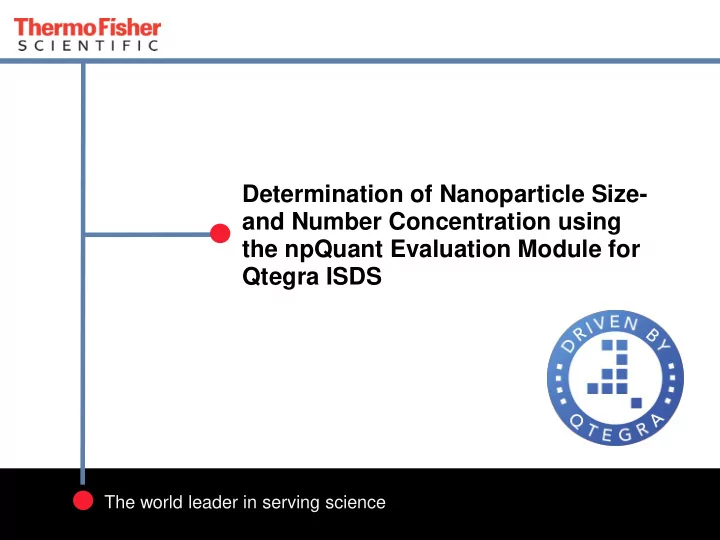

Determination of Nanoparticle Size- and Number Concentration using the npQuant Evaluation Module for Qtegra ISDS The world leader in serving science 1
A Task Set for a Modern ICP- MS Lab… Sample Prep Pb HPLC-ICP-MS Cr Cd Hg As Quality Total Element Control Speciation IC-ICP-MS Quantification Analysis Si Nanoparticle Al Ce Characterization Ti Ag spICP-MS FFF-ICP-MS 2
Nanoparticle Characterization… sp-ICP-MS FFF HDC Soil Au Ti Ag Matrix Method Effects Environmental Development Waters Impact/Fate Sample Prep Ce Human Health Food Si Tissues Fe Al Serum C Breath 3
Key Requirements • User Guidance through Method Defintion • Automated Determination of key input parameters • Options to effectively judge Data Quality • Recognition of artefacts or false positives • Ease of use in Routine Application • Same look and feel for lab personnel • Training requirements • Option to seamlessly switch to different applications 4
The Nanodefine EU project • The research leading to these results has received funding from the European Union Seventh Framework Programme (FP7/2007-2013) under grant agreement no. 604347 • Thermo Fisher is one partner among many others, academic and industry www.nanodefine.eu 5
Thermo Scientific iCAP Q for spICP-MS • Increased Detection Sensitivity through dedicated high sensitivity skimmer cone insert • Fast data acquisition and real-time display during measurement in the single-particle mode (as low as 0.1ms) • Dedicated evaluation software for Qtegra ISDS Straightforward setup, no peripherals required Direct information about particle size and concentration 6
Artefacts in spICP-MS A C B dwell dwell Intensity [cts] time time ~ 300 µs - Split Particle Events (B): A nanoparticle signal is observed in two adjacent measurement slots. The extent of split particle events depends on the nanoparticle pulse duration and the applied dwell time, and can be reduced by using longer dwell times. - Double or Multiple Particle Events (C): Two or more particles are observed in one measurement slot, leading to an overestimation of the particle size. The occurrence of such events can be estimated using Poisson statistics and can be reduced by sample dilution. 7
npQuant - A new Evaluation Module • npQuant Evaluation Module • Dedicated solution for spICP-MS data acquisition and evaluation • Available as add-on to Qtegra ISDS 2.6 • Create Templates and LabBooks • Uses Qtegra platform architecture to control peripheral devices • LabBooks using different evaluation modules can be easily mixed 8
Features • Default Evaluation Parameters can be determined through npQuant • Transport Efficiency through particle measurement* • Option to manually insert value • Detection Sensitivity through calibration with ionic standards * Pace et al. , Anal. Chem. 83 (2011), 9361-9369 9
Features • Multiple particle fractions can be evaluated • Different size regimes in one sample • Editor allows to create user defined materials • Composite materials, specific density 10
Single Particle ICP-MS for Characterization of AgNPs • Raw data visualization • Overlay or stack samples even in real time • Direct data export 11
Data Evaluation • Signal Distribution view • Identify particle fractions • Modify particle fraction thresholds • Statistical Data Evaluation • Recognize and eliminate artefacts 12
Statistical Data Evaluation • Correct for split particle events* • Proposal of dilution factor based on filled slot ratio • Poisson statistics to assess muliple particle events * Liu et al. , Anal. Chem. 86 (2014), 3405-3414 13
Particle Size and Concentration Evaluation • Display of all particle fractions per sample • Calculates mass concentration for comparison 14
Results • Analysis of NIST 8013 • Analysis of NIST 8012 in presence of NIST 8013 • Au NP with 60nm nominal • 30 and 60 nm nominal diameter diameter • Result: 58.1 ± 3.0 nm • Result 27.4 ± 2.5 nm approx. 21,000 partilces/mL 15
Conclusion • spICP-MS is straightforward way to characterize nanoparticles • Increased detection sensitivity is the key to detect smaller and smaller nanoparticles • Easy experimental setup, short analysis time per sample • The npQuant evaluation module guides the user through method set-up and aids in data evaluation • Automated determination of key parameters • Statistical evaluation of data sets On the way to routine characterization of Nanomaterials! 16
Question and Answer Session 17
Recommend
More recommend